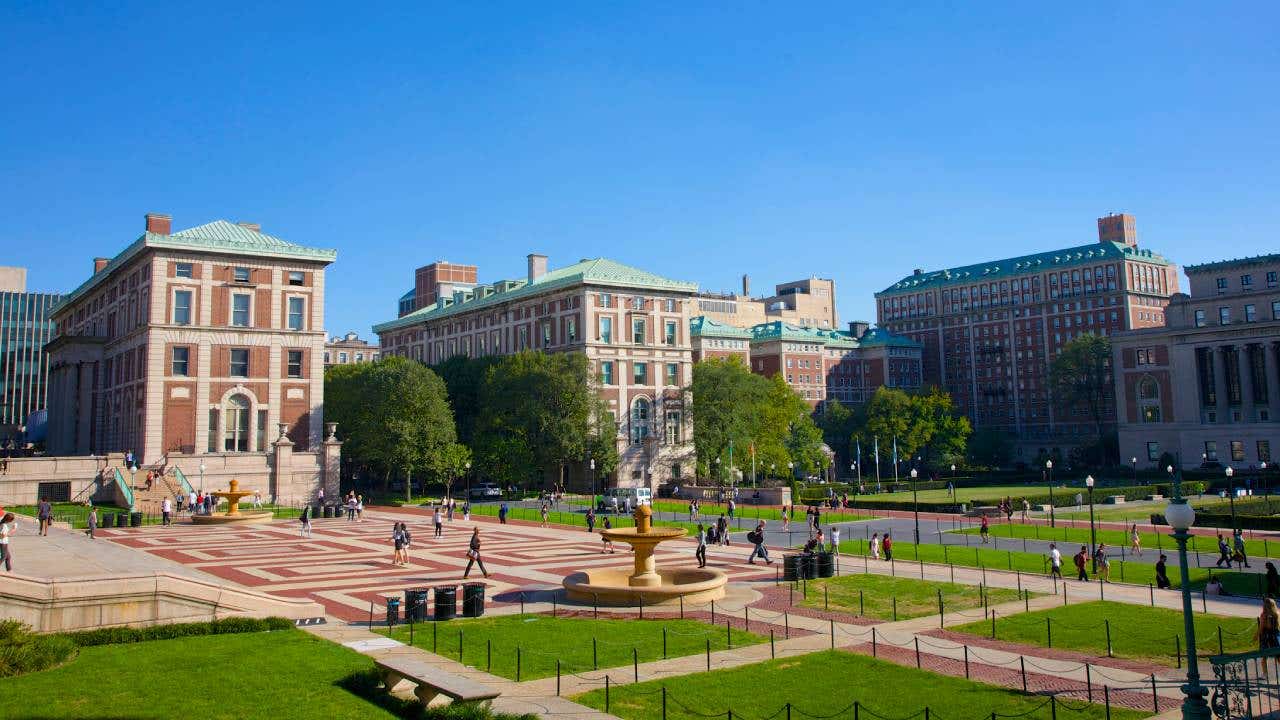Paying for college in a recession: Statistics and predictions 2024

The Bankrate promise
At Bankrate we strive to help you make smarter financial decisions. While we adhere to strict , this post may contain references to products from our partners. Here's an explanation for .
Today’s rapid inflation has many worried about the cost of everything, including tuition. While inflation has declined from its peak levels, it remains higher than it has been for much of the last decade. That has many concerned about the risk of a recession. A recent Bankrate survey found that just under half of economists now forecast a recession, but consumers remain worried.
According to predictions by the Massachusetts Educational Financing Authority, the average cost of college at public four-year institutions could grow by 9.3 percent by 2026. During a recession, tuition and borrowing could become even more expensive, especially for bad-credit borrowers. Here’s what to know.
- Historically, higher education institutions are the first to experience budget cuts during a recession.
- Since colleges and universities — especially public ones — rely heavily on state and local funding, decline in budgets directly correlates to higher tuition costs.
- States like Washington, Alabama and California, which were hit the hardest by the Great Recession, increased their four-year tuition by close to $3,000 on average in the years that followed.
- Meanwhile, Iowa, Maine, New York and Maryland, which were least affected, raised their four-year tuition by less than half that amount.
- College enrollment tends to increase during economic downturns as many go back to school in hopes of improving their job prospects.
- During the 2023-24 academic year, full-time resident students at public four-year colleges paid an average of $11,260 in tuition and fees, while non-resident students paid an average of $29,150.
- Students at private nonprofit four-year institutions paid even more: a whopping $41,540 for tuition and fees.
- Although grant aid per undergraduate student has increased by an average of 26 percent over the last decade, and student borrowing has continued to decline, Americans think quality, affordable college is not accessible to most.
- Regardless of the cost, college degrees are still the best path to high-paying jobs. According to the Bureau of Labor Statistics, bachelor’s degree holders earn about 68 percent more weekly than those with only a high school diploma.
Recession vs. depression
The National Bureau of Economic Research defines a recession as “a significant decline in economic activity that is spread across the economy and that lasts more than a few months.”
Recessions are marked by a contraction of a country’s gross domestic product, or GDP — the value of goods and services produced or sold by a country. Recessions can be caused by factors including long inflationary or deflationary periods, the bursting of an asset bubble or a stock market crash.
The most recent U.S. recession was the COVID-19 recession of 2020, which only lasted about two months, according to NBER. Massive market uncertainty due to the pandemic’s effects, investors losing confidence and a slow manufacturing process triggered that recession.
Previously, we had the 18-month Great Recession of 2008, largely caused by the housing bubble bursting.
A depression, on the other hand, is essentially a more-extreme recession. They last years instead of months, and the decline of economic activity is far steeper. However, they are rare. The most recent one, the Great Depression, took place between 1929 and 1939 and was largely triggered by a steep fall in stock prices in the U.S.
College tuition and recession: What to expect
To better understand what to expect from college prices during a recession, it’s important to examine the patterns of what has happened before.
College and the Great Recession
- During the Great Recession, college enrollment increased rapidly, peaking at 11.65 million students nationwide in 2011 — followed by a 10-year decline.
- The share of education revenue paid by college students rose by 31 percent between 2008 and 2012.
- Those who graduated immediately after the Great Recession had an average student loan balance of $28,700 — $4,000 higher than those who graduated before the recession.
- College tuition has continued to increase by an average of $500 per year following the Great Recession.
Where we are now
Despite a stretch of sky-high inflation and rising interest rates that would typically indicate a recession, the economy has avoided such a slump. Economists are now split on whether a recession is on the horizon, with a 52 percent majority believing it can be avoided.
“It is quite remarkable that we’ve gone close to two years now where we’ve been on high alert for a recession, and yet one has yet to materialize for the broader U.S. economy,” says Mark Hamrick, Bankrate senior economic analyst. “Unfortunately, the odds of an economic contraction remain elevated.”
According to a study by the Lumina Foundation, college tuition prices tend to rise when a recession hits. That’s because higher education is one of the first categories where state and local governments cut spending.
Nicole Smith, research professor and chief economist at the Georgetown University Center on Education and the Workforce, says it’s hard to predict how tuition costs will change for specific institutions during the possible upcoming recession due to factors including caps established by each state.
“Depending on the state you’re from, the state legislature might make the decision regarding how much tuition is allowed to be changed,” Smith says. “There are some cases in which the state’s education boards will make this call. In general, political organizations largely determine the extent to which tuition can move or not,” she adds.
However, Smith says that one thing is certain: It will cost more to attend college next year. Reasons include increases in the cost of living and wages.
Here’s a prediction of how college costs may look in the upcoming years, assuming a 3 percent annual increase in fees, tuition and other expenses:
| Academic year | Public two-year | Public four-year (in-state) | Public four-year (out-of-state) | Private four-year |
|---|---|---|---|---|
| 2024 | $14,290.22 | $24,666.44 | $43,020.01 | $56,683.99 |
| 2025 | $14,718.93 | $25,406.43 | $44,310.61 | $58,384.51 |
| 2026 | $15,160.49 | $26,168.63 | $45,639.93 | $60,136.04 |
| 2027 | $15,615.31 | $26,953.68 | $47,009.13 | $61,940.13 |
Source: Massachusetts Educational Financing Authority
Recession watchlist: States at risk for largest tuition spikes
Although tuition costs rose across the board during the Great Recession, the hardest-hit states increased their tuition costs more sharply due to higher budget cuts. For instance, Iowa, one of the states least affected by the Great Recession, increased tuition by an average of $800 to $1,100 during the 2012-13 academic year. Meanwhile, California, one of the most-impacted states, increased tuition by close to $5,000 at some institutions.
According to a data analysis by Merchant Maverick, the following states (listed alphabetically) are at risk of being hit the hardest if a recession unfolds due to factors that make their economies more unstable than others. These include low government reserves, high unemployment rates, lack of affordable housing and more.
- Arizona
- Arkansas
- Florida
- Hawaii
- Idaho
- Kentucky
- Maine
- Mississippi
- Nevada
- New Mexico
Since these states are less financially prepared to weather a recession compared to others, they could suffer larger budget cuts. That means institutions in these states may have to increase their tuition costs more to stay afloat.
How to prepare for a recession
Recessions are a natural part of the economic cycle, and there’s not much individuals can do to escape them. However, you can do a few things to protect yourself as a college student and lessen the impact on your wallet.
Carefully evaluate your major’s potential
Smith says that one of the things that can help you land on your feet if a recession hits is knowing your desired major’s likely return on investment.
“You have to be proactive,” Smith says. “Make sure you get the appropriate counseling so that you know what the long-term opportunities are for that major in terms of getting into a job and getting into a career and ways in which you can move along your career pathway,” she adds.
This research will help you determine how much to spend on your education based on your expected salary. It will also allow you to better prepare for your targeted job market once you graduate.
Maximize your gift aid
Both scholarships and grants are a form of gift aid: money you don’t have to pay back. Maximizing these resources can significantly cut your college costs, including how much you need to borrow to pay for your degree. This, in turn, will put you in a better financial position once you graduate.
To apply for scholarships and grants, you must first fill out the FAFSA. Then, use a scholarship search tool, such as Scholarships360 or Unigo, to find out which scholarships and grants you may qualify for and apply to as many as possible.
Borrow the smart way
If you still need more money to pay for school after maximizing free aid, your best bet is applying for federal student loans. Federal student loans offer protections, like income-driven repayment and access to forgiveness programs, that private student loans don’t. If you have no credit or poor credit, they will also likely offer lower interest rates than private student loans.
Plus, you don’t need to pass a credit check to qualify for federal student loans – you just need to be in good academic standing and be enrolled in school at least part-time.
However, sometimes, federal student loans also fall short. If that’s the case, private student loans are your second-best option. To qualify, you’ll need good credit and a stable source of income or a co-signer that meets these requirements. Before choosing a lender, compare several options to ensure you get the best terms and rates.
Whether you go for federal or private student loans, crunch the numbers and only borrow what you need and can potentially afford to repay after graduating. This is especially important if you expect to graduate during a recession.
“If you enter the labor market during a recession, you’re gonna get a lower salary than you ought to have gotten if you didn’t,” Smith says. “By the time a year or two has passed, even if they were to get a salary bump, it is not going to compensate for the lower wage that you started off with,” she adds.
Consider taking a work-study job or a part-time job
Another way to reduce a recession’s impact on your budget is to work part-time to cover some college costs. You can take a work-study job, a form of federal aid awarded on a first-come, first-served basis, or a regular part-time job.
Both will give you some footing in the professional world. You’ll have real-world work experience and something to list on your resume, giving you an advantage over your peers once you start looking for jobs after graduation.
Related Articles



College tuition inflation: How the cost of college has risen over time
